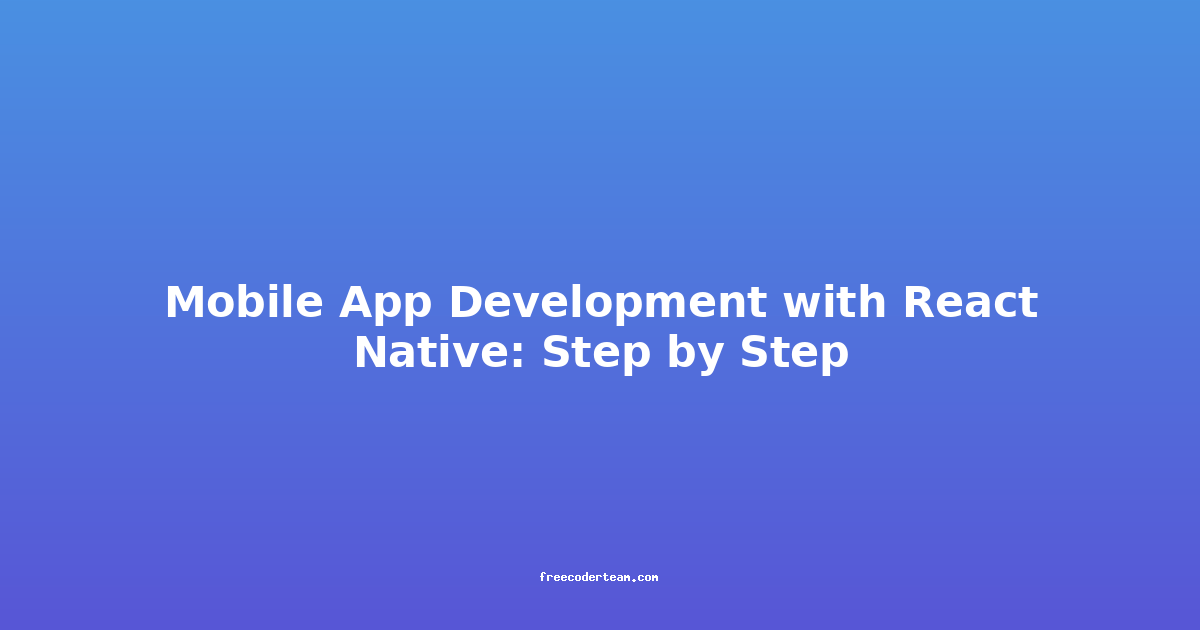Mobile App Development with React Native: Step by Step
React Native is one of the most popular frameworks for building cross-platform mobile applications. It allows developers to write code once and deploy it on both iOS and Android platforms, reducing development time and costs. In this comprehensive guide, we'll walk through the process of building a simple React Native app from scratch. We'll cover setup, development, and best practices to ensure your app is robust and maintainable.
Table of Contents
- Introduction to React Native
- Setting Up Your Development Environment
- Creating Your First React Native App
- Building the App: Step by Step
- Best Practices in React Native App Development
- Testing and Deployment
- Conclusion
Introduction to React Native
React Native is a JavaScript framework developed by Facebook that allows developers to build mobile applications using React, a popular frontend library. It uses JavaScript and XML (JSX) to create native UI components, which means the apps you build will look and feel like native iOS or Android apps.
Key benefits of React Native include:
- Code Reusability: Write code once and deploy it on both iOS and Android.
- Performance: Apps built with React Native are fast and performant.
- Huge Community: Access to a vast library of open-source components and tools.
- Easy Learning Curve: If you already know React, learning React Native is straightforward.
Setting Up Your Development Environment
Before you start building your app, you need to set up your development environment. Follow these steps:
1. Install Node.js and npm
React Native requires Node.js and npm (Node Package Manager). You can download Node.js from nodejs.org. Once installed, verify the installation by running:
node -v
npm -v
2. Install React Native CLI
You can use the React Native CLI to create and manage your projects. Install it globally using npm:
npm install -g react-native-cli
3. Install Expo (Optional)
Expo is a popular tool that simplifies React Native development. It allows you to build, test, and deploy apps without needing to set up Xcode or Android Studio. Install Expo CLI globally:
npm install -g expo-cli
4. Install an Emulator or Simulator
For testing your app, you'll need to set up an emulator for Android or a simulator for iOS. You can use:
- Android: Android Studio (comes with an emulator)
- iOS: Xcode (comes with a simulator)
Alternatively, you can use Expo Go, which is a mobile app that allows you to test your React Native apps on physical devices without the need for emulators or simulators.
Creating Your First React Native App
Now that your environment is set up, let's create a simple React Native app.
1. Install Dependencies
First, create a new React Native project using the React Native CLI:
npx react-native init MyAwesomeApp
OR, if you prefer using Expo:
npx create-expo-app MyAwesomeApp --template tabs
2. Navigate to Your Project
cd MyAwesomeApp
3. Start the Development Server
For React Native CLI:
npx react-native run-android
# or
npx react-native run-ios
For Expo:
npx expo start
This will start a development server and open your app in the default emulator or simulator.
Building the App: Step by Step
Let's build a simple todo app with React Native. The app will have two screens: a Todo List and a Todo Details screen.
Step 1: Designing the UI
We'll use React Native's built-in components to design the UI. Open the App.js file and replace the default code with the following:
import React, { useState } from 'react';
import { SafeAreaView, StyleSheet, Text, View, TextInput, Button, FlatList } from 'react-native';
const App = () => {
const [todos, setTodos] = useState([]);
const [newTodo, setNewTodo] = useState('');
const addTodo = () => {
if (newTodo.trim() !== '') {
setTodos([...todos, newTodo]);
setNewTodo('');
}
};
const renderTodo = ({ item }) => (
<View style={styles.todoItem}>
<Text>{item}</Text>
</View>
);
return (
<SafeAreaView style={styles.container}>
<Text style={styles.title}>Todo App</Text>
<TextInput
style={styles.input}
placeholder="Add a new todo..."
value={newTodo}
onChangeText={setNewTodo}
/>
<Button title="Add Todo" onPress={addTodo} />
<FlatList
data={todos}
renderItem={renderTodo}
keyExtractor={(item, index) => index.toString()}
/>
</SafeAreaView>
);
};
const styles = StyleSheet.create({
container: {
flex: 1,
padding: 20,
},
title: {
fontSize: 24,
fontWeight: 'bold',
marginBottom: 20,
},
input: {
borderWidth: 1,
borderColor: '#ddd',
padding: 10,
marginBottom: 10,
},
todoItem: {
backgroundColor: '#f0f0f0',
padding: 10,
marginBottom: 10,
borderRadius: 5,
},
});
export default App;
Step 2: Implementing the Logic
The app uses the useState hook to manage the state of the todos and the input field. When the user adds a new todo, it's added to the todos array, and the input field is cleared.
Step 3: Adding Functionality
To add more functionality, you can implement features like:
- Marking Todos as Completed
- Deleting Todos
- Persisting Data (using
AsyncStorageor a database)
Example of marking todos as completed:
const [todos, setTodos] = useState([]);
const [newTodo, setNewTodo] = useState('');
const toggleComplete = (index) => {
const updatedTodos = todos.map((todo, i) => {
if (i === index) {
return { ...todo, completed: !todo.completed };
}
return todo;
});
setTodos(updatedTodos);
};
const renderTodo = ({ item, index }) => (
<View style={styles.todoItem}>
<Text style={item.completed ? styles.completedText : styles.todoText}>{item.text}</Text>
<Button title="Toggle" onPress={() => toggleComplete(index)} />
</View>
);
Best Practices in React Native App Development
1. Use Expo for Quick Starts
Expo simplifies the development process by handling native dependencies and bundling. It's great for prototyping and rapid development.
2. Write Modular Code
Break your app into reusable components. Use functional components with hooks for better readability and maintainability.
3. Use React Navigation
React Navigation is the go-to library for managing navigation in React Native apps. It provides a clean API for routing and navigation.
4. Optimize Performance
- Use
PureComponentorReact.memofor components that don't need to re-render. - Use
FlatListinstead ofScrollViewfor large lists to improve performance. - Avoid unnecessary re-renders by optimizing state updates.
5. Test Your App
Use tools like Jest and React Testing Library to write unit tests and ensure your app works as expected.
Testing and Deployment
Testing
- Unit Tests: Use Jest and React Testing Library for testing components.
- Integration Tests: Use Detox or Appium for end-to-end testing.
Deployment
- Android: Use the
react-native run-androidcommand to build the APK. You can then upload it to the Google Play Store. - iOS: Use Xcode to archive and distribute your app on the App Store.
Conclusion
React Native is a powerful and flexible framework for building cross-platform mobile apps. By following the steps outlined in this guide, you can create a functional and scalable app from scratch. Remember to adhere to best practices such as modularity, performance optimization, and thorough testing to ensure your app is robust and user-friendly.
With React Native, the possibilities are endless. Start building your next app today and leverage the power of cross-platform development!
This guide should give you a solid foundation for developing React Native apps. Happy coding! 🚀




